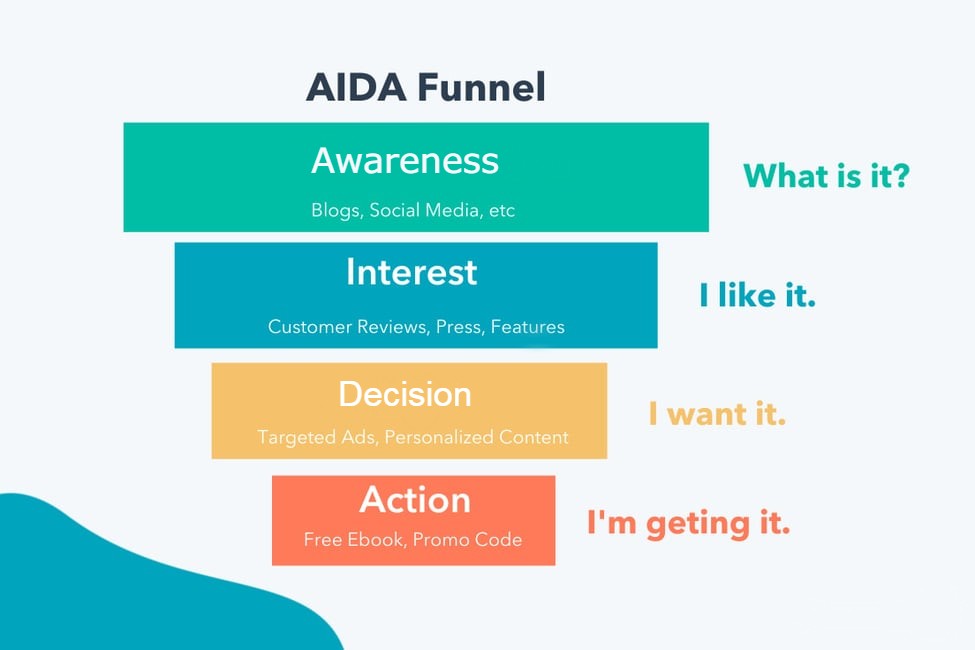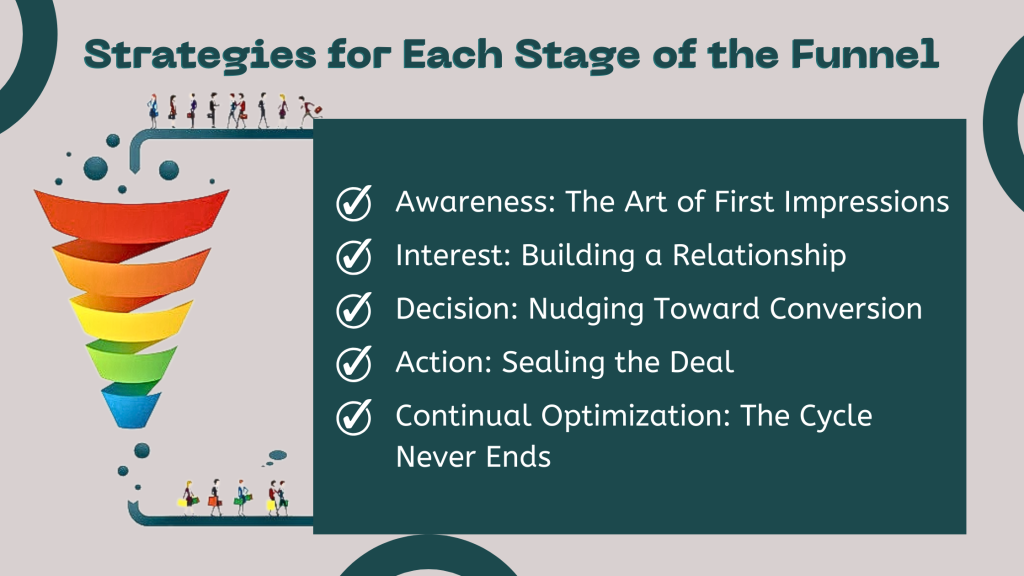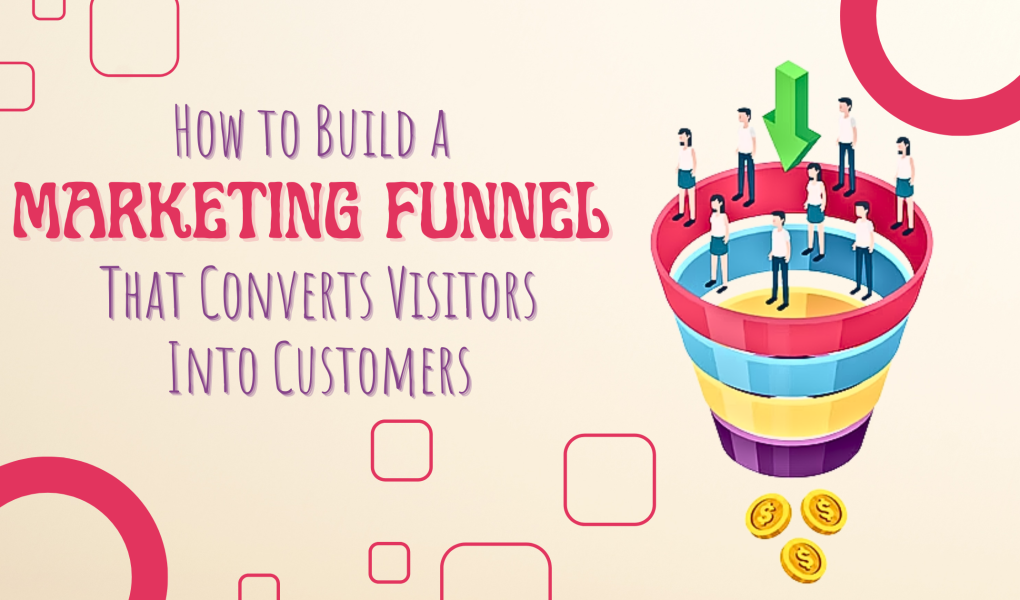Businesses need marketing funnels to succeed online. A marketing funnel is a process that helps businesses attract, engage, and convert leads into customers. By building a well-designed marketing funnel, you can increase your website traffic, generate more leads, and close more deals.
According to a recent study by HubSpot, businesses with well-defined marketing funnels have a conversion rate that is 10% higher than those without. Additionally, businesses that use marketing funnels are 40% more likely to close deals than those that don’t.
One of the most common challenges that businesses face in the SEO field is generating high-quality leads. A well-designed marketing funnel can help you address this challenge by allowing you to target your ideal customers with relevant content and offers.
In this blog post, we will teach you how to build a marketing funnel that converts visitors into customers like crazy. We will cover everything from defining your target audience to creating high-quality content to nurturing your leads to closing the deal.
Table of Contents
What is a Marketing Funnel?
A marketing funnel is a structured framework that delineates the customer’s journey from initial brand awareness to final conversion. It serves as a strategic model for businesses to attract, engage, and retain customers effectively.
The purpose of a marketing funnel is to help businesses attract, engage, and convert leads into customers. By understanding the different stages of the funnel and creating targeted campaigns, businesses can move customers through the buying process more efficiently.
A typical marketing funnel has four stages: awareness, interest, decision, and action (AIDA).

- Awareness: At the awareness stage, potential customers are not yet familiar with your brand or product. Your goal is to make them aware of your existence and generate interest in what you have to offer.
- Interest: Once potential customers are aware of your brand, they may start to learn more about what you have to offer. Your goal is to nurture their interest and convince them to consider your product or service as a solution to their needs.
- Decision: At the decision stage, potential customers are comparing different products or services and deciding which one to purchase. Your goal is to position your product or service as the best option and persuade them to buy from you.
- Action: At the action stage, potential customers are ready to make a purchase. Your goal is to make it as easy as possible for them to buy from you.
One of the biggest challenges businesses face is generating leads and converting them into customers. A marketing funnel can help businesses overcome this challenge by providing a clear roadmap for guiding potential customers through the buying process.
Now it’s time to build your own marketing funnel!
Why Your Business Needs a Marketing Funnel

If you’re in the business of, well, any business, you know that attracting potential customers is only half the battle. The real challenge lies in converting those leads into actual sales. According to Forrester Research, businesses with a well-defined marketing funnel can increase conversions by up to 15%. So, what’s a marketing funnel, and why is it the game-changer your business needs? Let’s break it down.
A Roadmap for Customer Conversion
A marketing funnel serves as a strategic roadmap, guiding potential customers from initial awareness to final purchase. Think of it as a GPS for your marketing efforts, helping you navigate the complex journey of customer acquisition and retention.
Optimized Marketing Spend
One of the biggest challenges businesses face is allocating their marketing budget effectively. A well-structured funnel allows you to identify which strategies are yielding results and which are not. This enables you to allocate your resources more wisely, ensuring a higher ROI.
Identifying and Fixing Bottlenecks
A funnel isn’t just about pushing customers toward a sale; it’s also about understanding where they drop off in the process. By identifying these bottlenecks, you can fine-tune your strategies to address specific issues, thereby improving overall conversion rates.
According to a study by Forrester Research, businesses that implement a structured marketing funnel experience a 10-15% increase in customer conversions. These numbers aren’t trivial; they can make a significant impact on your bottom line.
Consider the case of Grasshopper, a virtual phone system that enables businesses to set up toll-free numbers. They were already doing well but aimed to simplify their sales funnel for better results. The outcome? Their annual revenue soared to over $30 million.
- Awareness
In the initial stage, Grasshopper uses a mix of content types, including YouTube videos and blog posts, as well as paid advertising to spread its message. What sets them apart is their unique approach to content, such as their humorous “80’s Entrepreneur Training” video, which garnered over 260,000 views. - Interest
After engaging with a video or blog post, prospects find pathways that lead them to Grasshopper’s homepage. For instance, a link to their website is presented at the end of their YouTube videos. On the homepage, they highlight unique selling points, offer a money-back guarantee, and include a CTA that guides visitors to a detailed sales page. - Decision
Upon clicking the “sign up” link, prospects are directed to a pricing page featuring multiple plans and a 30-day money-back guarantee. The page also includes endorsements from recognized brands and press features as social proof to enhance conversions.
The funnel’s effectiveness is not just due to its simplicity but also its focus on tailored messaging that addresses the specific needs and concerns of its target audience. Grasshopper’s long-form sales page, which precedes the pricing page, ensures that the leads they capture are highly qualified.
This isn’t just another success story; it’s a clear demonstration of how a well-optimized sales funnel can significantly impact a company’s bottom line.
See also: How to Grow Your YouTube Channel in 2023
Why You Can’t Afford to Ignore It
Ignoring the concept of a Marketing Funnel is akin to leaving money on the table. Without a structured approach to conversion, you’re essentially shooting in the dark, hoping that your uncoordinated efforts will somehow result in sales.
A well-planned digital marketing funnel not only increases your conversion rates but also improves customer retention, maximizes ROI, and provides valuable insights into customer behavior.
In summary, a Marketing Funnel is not just a nice-to-have element in your business strategy; it’s a must-have. By understanding and implementing a well-thought-out digital marketing funnel, you’re setting your business up for long-term success.
The Building Blocks of a High-Converting Marketing Funnel
A digital marketing funnel is a strategic framework that businesses use to guide potential customers through the buying process, from awareness to purchase. It helps businesses to attract, engage, and convert leads into customers.
A high-converting digital marketing funnel is one that is well-designed and optimized to move leads through the funnel as efficiently as possible.
It is important to note that there is no one-size-fits-all digital marketing funnel, as the specific steps involved will vary depending on your business and industry.
However, there are some key building blocks that all high-converting digital marketing funnels have in common:
1. Awareness: The first step in any digital marketing funnel is to make potential customers aware of your brand and products or services. This can be done through a variety of channels, such as search engine optimization (SEO), social media marketing, and paid advertising.
2. Interest: Once potential customers are aware of your brand, you need to generate interest in what you have to offer. This can be done by creating high-quality content that is relevant to your target audience and that addresses their pain points.
3. Decision: Once potential customers are interested in what you have to offer, you need to help them make a decision about whether or not to purchase from you. This can be done by providing them with information about your products or services, as well as customer testimonials and reviews.
4. Action: The final step in any digital marketing funnel is to get potential customers to take action, such as signing up for your email list, making a purchase, or downloading a white paper. This can be done by creating clear and compelling calls to action throughout your funnel.
Here are some tips for building a high-converting digital marketing funnel:
Define Your Target Audience
The first step in building any successful marketing funnel is to define your target audience. This means identifying the specific group of people that you are trying to reach with your marketing campaigns. Once you know who your target audience is, you can tailor your content and messaging accordingly.
Here are some questions you can ask yourself to help you define your target audience:
- What are their demographics (e.g., age, gender, location, income level, education level)?
- What are their psychographics (e.g., interests, values, lifestyle)?
- What are their pain points and challenges?
- What are their goals and aspirations?
- Where do they spend their time online?
Once you have a good understanding of your target audience, you can create a buyer persona. A buyer persona is a fictional representation of your ideal customer.
It is based on your research and understanding of your target audience, and it can help you to create more targeted and effective marketing campaigns.
Create High-Quality Content That Is Relevant to Your Target Audience
Once you know who your target audience is, you need to create high-quality content that is relevant to their needs and interests. Your content should be informative, engaging, and well-written. It should also be optimized for search engines so that people can easily find it.
Here are some tips for creating high-quality content:
- Do your research and make sure that your content is accurate and up-to-date.
- Write in a clear and concise style.
- Use images and videos to make your content more engaging.
- Promote your content on social media and other channels.
Use Multiple Channels
Don’t rely on just one channel to reach your target audience. Use a variety of channels, such as SEO, social media marketing, and paid advertising, to reach your ideal customers where they are spending their time online.
Here are some tips for using multiple channels effectively:
- Choose the channels that are most relevant to your target audience.
- Tailor your content and messaging to each channel.
- Create a consistent brand experience across all channels.
- Track the results of each channel so that you can see what’s working and what’s not.
See also: How to Make Your Website for Free
Strategies for Each Stage of the Funnel

Now that you understand the building blocks of a high-converting Marketing Funnel, the next step is to implement effective strategies for each stage. A well-planned digital marketing funnel doesn’t just happen; it’s the result of careful planning and execution. Let’s explore the strategies that can make each stage of your funnel more effective.
Awareness: The Art of First Impressions
The Awareness stage is your first opportunity to make an impression. It’s crucial to not only attract potential customers but also to attract the right ones.
SEO (Search Engine Optimization):
Utilize keyword research to identify what your target audience is searching for.
Optimize your website’s meta descriptions, titles, and content to improve search engine rankings.
Social Media Marketing:
Identify which platforms your target audience frequents and establish a presence there.
Use eye-catching visuals and compelling copy to draw attention.
PPC (Pay-Per-Click) Advertising
Consider using paid ads for immediate visibility.
Target your ads based on demographics, location, and even behavior.
Interest: Building a Relationship
Once you’ve captured attention, the next step is to cultivate interest. This is where you begin to build a relationship with potential customers.
Content Marketing:
Create a variety of content types such as blogs, videos, and podcasts, that offer value to your audience.
Use storytelling to make your brand more relatable and memorable.
Email Marketing:
Develop a series of automated emails that provide valuable information over time.
Personalize emails to make recipients feel special and seen.
Decision: Nudging Toward Conversion
When potential customers reach the Decision stage, they’re seriously considering whether to take action. Your role is to make that decision as easy as possible for them.
Webinars and Product Demos:
Live webinars allow for real-time interaction and can address questions or objections on the spot.
Recorded demos can be accessed at the viewer’s convenience, providing flexibility.
Customer Testimonials and Reviews:
Showcase positive reviews on your website and social media.
Consider creating case studies for more in-depth testimonials.
Action: Sealing the Deal
The Action stage is where the conversion happens. It’s crucial to make this process as smooth as possible to ensure that you don’t lose the customer at the last moment.
Streamlined Checkout Process:
Minimize the number of steps required to complete a purchase.
Offer multiple payment options for convenience.
Strong and Clear CTAs (Call to Action):
Use action-oriented language that guides the user.
Make your CTA buttons stand out with contrasting colors.
Continual Optimization: The Cycle Never Ends
A Marketing Funnel is not a one-and-done deal; it requires ongoing optimization.
Data Analytics:
Regularly review metrics like bounce rate, time spent on a page, and conversion rates.
Use this data to identify areas for improvement.
A/B Testing:
Run controlled experiments to test different elements like headlines, images, or CTA buttons.
Use the results to refine your strategies continually.
By implementing these comprehensive strategies tailored to each stage of your digital marketing funnel, you’re setting the stage for higher conversion rates and long-term customer relationships. Remember, the most effective funnel is one that is continually monitored and optimized, so never stop testing and improving.
Close the deal
You’ve done a lot to get people interested in what you’re selling. Now, it’s time to make sure they actually buy it. This is the last and most important part of your Marketing Funnel. Let’s talk about how to make it work.
Make Buying Easy
People don’t like complicated stuff. If buying from you is hard, they might just give up. So, make it easy.
- Fewer Clicks: Try to make it so people can buy what they want in just a few clicks.
- Payment Choices: Let people pay how they want. Some like credit cards, and some like digital wallets. Give options.
The Final Push: Your CTA
Your CTA, or “Call to Action,” is like a sign that says “Buy Now!” It needs to be easy to see and tell people exactly what to do.
- Clear Words: Use simple words that tell people to take action now, like “Buy,” “Get It,” or “Start.”
- Stand Out: Make the button or link really easy to see. Use a color that’s different from everything else on the page.
After They Buy: Keep Talking
Just because someone bought something doesn’t mean you stop talking to them. Keep the relationship going.
- Say Thanks: Send them to a page that says “Thank You” after they buy. Maybe show them other stuff they might like.
- Check-In Emails: Send an email to say thanks, give tips on using what they bought, and maybe offer a deal for next time.
Keep an Eye on the Numbers
Even after you make the sale, look at how you’re doing. This can help you do even better next time.
- Did They Buy?: Look at how many people actually bought something. If it’s low, you might need to make some changes.
- How Much Did They Spend?: See how much people are spending on average. This can help you think of other things to sell them later.
By doing these things in the last part of your Marketing Funnel, you’re not just making a sale. You’re also making it more likely that the person will buy from you again. And that’s what a good Marketing Funnel is all about not just one sale, but many.
See also: The Science of Viral Content: What Makes a Post Go Viral?
Measuring and Optimizing Your Funnel
Once you’ve set up your Marketing Funnel, the next crucial step is to measure and optimize its performance. By tracking key metrics and employing strategies like A/B testing, you gain valuable insights into what’s effective and what needs tweaking. This ongoing process not only enhances your funnel but also elevates your business results over time.
Key Metrics to Track
First up, you’ve got to know what to look for. There are some really important numbers that can tell you how well your funnel is doing.
- Conversion Rates: This is all about how many people go from just looking to actually buying. If this number is low, you’ve got some work to do.
- Customer Lifetime Value: This tells you how much a customer is worth over time. If you keep them happy and they keep buying, this number goes up.
- ROI (Return on Investment): This shows if the money you’re spending on your funnel is worth it. If you’re spending $100 to make $10, something’s wrong.
- Using Analytics Tools: There are tools out there that can help you keep an eye on these numbers. Google Analytics is a good one to start with. It can show you all these metrics and more.
A/B Testing for Continuous Improvement
So you’ve got your numbers. Now what? This is where A/B testing comes in. It’s a way to try out different things and see what works best.
- What Is A/B Testing?: It’s when you make two versions of something, like a webpage. Version A might have a red “Buy Now” button, and Version B might have a green one. You see which one people click more.
- How to Do It Right:
- Pick One Thing: Don’t change too many things at once. If you do, you won’t know what made the difference.
- Use Enough Time: Run your test for a good amount of time. A day or two usually isn’t enough to get clear results.
- Look at the Data: Once the test is done, check the numbers. Did one version get more clicks or sales? That’s the winner.
By keeping an eye on the right numbers and always looking for ways to do better, you can make your Marketing Funnel really work for you. It’s not just about making a quick sale; it’s about building a business that keeps growing.
See also: Top 7 Ways Machine Learning Takes Digital Marketing To The Next Level
Conclusion
Now that you know the basics of building a high-converting marketing funnel, it’s time to put your knowledge into action. But what if you need help getting started? Or what if you’re not sure how to optimize your funnel for maximum results?
That’s where Make Vision Clear comes in. We’re a team of experienced marketing experts who can help you build a marketing funnel that is tailored to your specific business and industry. We’ll work with you to define your target audience, create high-quality content, and use the right channels to reach your ideal customers.
We’ll also help you track and optimize your funnel so that you can see what’s working and what’s not. And we’ll always be there to provide you with support and guidance along the way.
If you’re serious about building a marketing funnel that converts visitors into customers like crazy, then you need to talk to Make Vision Clear. We can help you get the results you deserve.
Book a free 30-minute strategy session today to learn more about how we can help you build a high-converting marketing funnel.
What is a Marketing Funnel?
A marketing funnel is a model that illustrates the journey potential customers go through before making a purchase. It helps businesses understand and optimize the customer conversion process.
What is Funnel in Digital Marketing?
In digital marketing, a funnel is a series of online touchpoints that guide visitors from awareness to conversion. It often includes stages like awareness, consideration, and decision-making.
What Are the Stages of a Marketing Funnel?
The marketing funnel stages typically include:
1. Awareness
2. Interest
3. Consideration
4. Intent
5. Purchase
6. Retention
How Does a Digital Marketing Funnel Differ from a Traditional Marketing Funnel?
A digital marketing funnel incorporates online channels and tools, such as social media, email marketing, and SEO, to guide the customer journey, whereas a traditional funnel may include offline methods like print ads and in-store promotions.
What is Full Funnel Marketing?
Full funnel marketing addresses the entire customer journey, from the top of the funnel where awareness is generated, down to the bottom where conversions happen.
How Does Content Marketing Fit Into the Marketing Funnel?
Content marketing plays a crucial role in nurturing leads and guiding them through the funnel. Different types of content like blog posts, videos, and ebooks can be used at various stages to educate and engage potential customers.
What is a B2B Marketing Funnel?
A B2B marketing funnel focuses on converting businesses into customers. It often involves more complex decision-making processes and longer sales cycles compared to B2C funnels.
How Does Email Marketing Enhance the Marketing Funnel?
Email marketing allows you to send targeted messages to potential customers at different stages of the funnel. It’s an effective way to nurture leads and encourage them to take action.
What is Top of the Funnel Marketing?
Top-of-the-funnel marketing aims to attract a broad audience and generate awareness. It often involves tactics like social media advertising, SEO, and content marketing.
What Are the Key Elements of a Funnel Marketing Strategy?
A successful funnel marketing strategy includes:
1. Identifying target audiences
2. Creating compelling content
3. Utilizing various digital channels
4. Monitoring and analyzing performance metrics
How Can I Optimize My Marketing Funnel for Better Conversions?
To improve conversions, focus on understanding your audience’s needs, tailoring your content and offers accordingly, and continually analyzing data to make informed decisions.



